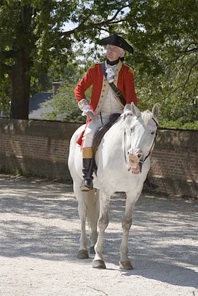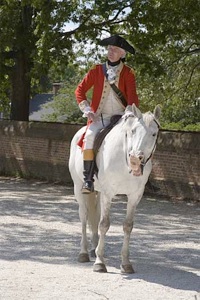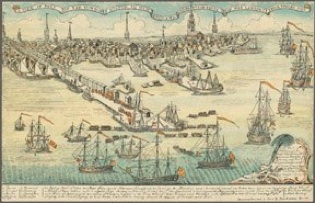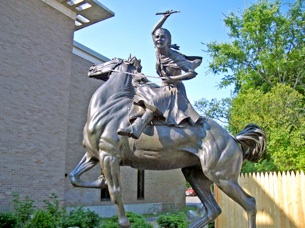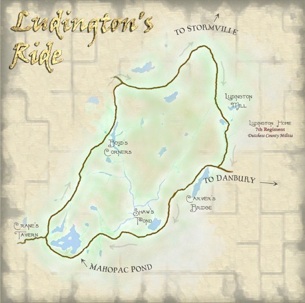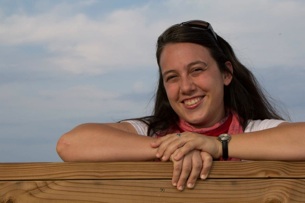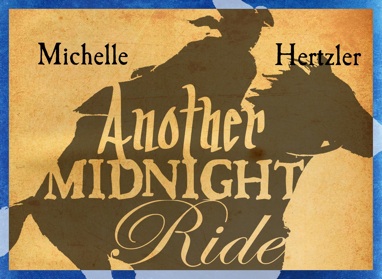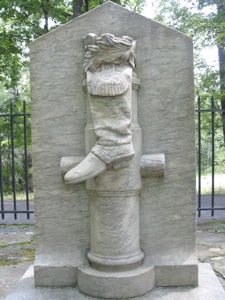Another Midnight Ride
by Michelle Hertzler
"Listen my children, and you shall hear
Of a lovely feminine Paul Revere
Who rode an equally famous ride
Through a different part of the countryside…."
("Sybil Ludington's Ride" by Berton Braley)
Spring rain saturated the recently cultivated wilderness of the Fredericksburg Precinct in Duchess County, New York. It was the evening of April 26th, 1777, and the family of Henry and Abigail Ludington were retiring for the night.
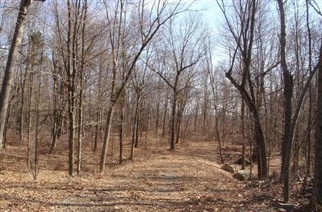
On April 25th British General William Tryon had debarked on Compo Beach in Connecticut, leading a force of 2,000 men. Tryon had been commissioned with the task of preventing the Continental Army from using supplies stored in the town of Danbury, CT. As if on parade, the men marched through Redding, Weston, and Bethel toward the unsuspecting Danbury. As news of Tryon's troops reached the Connecticut revolutionaries they mustered together what resistance they could, but none of the encounters resulted in full-fledged combat. Ironically, it was the heavy spring rains that caused the most difficulty, but even that did not stop the company from reaching their goal the following afternoon.
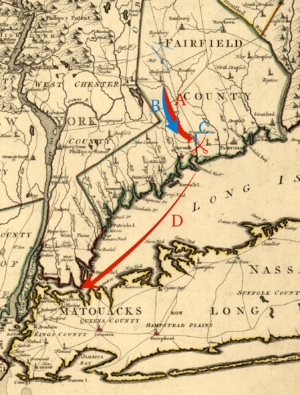
They remained in Danbury all day--securing control, terrifying the townsfolk, and destroying patriot military stores. Earlier hopes of carrying commandeered supplies to New York City for British use were abandoned since additional supplies would slow travel and inhibit their ability to fight. Goods found in royalist homes or in a Church of England were taken to the streets to be burned and the buildings left untouched. However, homes owned by revolutionaries containing supplies were burned to the ground. This continued into the night, soldiers becoming drunk as they helped themselves to the stores of rum and wine. Around one o'clock Tryon order the troops gathered and all the houses not marked with a cross (showing the residence was owned by Tories) to be torched.
Even through the rain the Ludington family most likely could see the fire glow in the eastern sky. How ironic that Henry, now a Colonel in the Continental Army, had once served under William Tryon before switching loyalties and resigning his commission in favor of the revolutionary cause. Small wonder that in response to this ultimate betrayal a bounty of three hundred guineas--dead or alive--was placed on Henry's head by General Howe! In a time when neighbor or friend could quickly turn against you, Colonel Ludington had to be very careful. There were many who had ideas of obtaining the reward. His family played a huge role in keeping his life out of their hands. Especially the watchfulness of his eldest daughter, Sybil.
Sybil was the first-born of the Ludington children (there would eventually be 12). In addition to household chores and the duties of an eldest sister, she was interested in her father's military role, often watching as he drilled his men. She was an able horsewoman, seeming to possess a keen and clever mind. It was her quick thinking that kept the notorious Tory, Ichobod Prosser, from capturing her father. One night she and her sister Rebecca were keeping watch outside the house and discovered the plot. Quickly informing the rest of the household, Sybil instructed her younger siblings (then numbering only 7, one being an infant) to fill the rooms with candlelight and march back and forth before the windows, giving the illusion that the house was strongly guarded. The ruse fooled Prosser and his men. They did not dare to attack and stayed hidden around the homestead, leaving at daybreak.
In recounting this incident Lewis S. Patrick (great-grandson of Colonel Henry Ludington) says this about Sybil: "Her constant care and thoughtfulness, combined with fortuitous circumstances, prevented the fruition of many an intrigue against [the Colonel's] life and capture." Perhaps it was this brave daughter who answered the door when the dispatch rider came with news of Danbury; we do not know for sure, but we do know that once again Sybil was there to assist her father and aid her country.
As the rider told of Tyron's capture of Danbury, the Colonel knew he must gather his regiment to join other militia in retaliation. It was too late to save Danbury, but if they could keep the British from advancing further into the Hudson Highlands the Americans might come out on top of this yet. Colonel Ludington realized then that there was no way he could sound the call to arms. He needed to remain on his farm to organize the men as they arrived from their homes in the surrounding counties. Turning to the dispatch rider, he saw the man was too spent to make the 40-mile trek. That left only one person who knew the way and could make the ride. But how could he ask her to make the journey in the rain and dark, over paths that were rough to travel in the daylight; through lonely stretches where "Cow Boys" and "Skinners" roamed - marauding, stealing, killing, and worse. Historians are not sure if Sybil volunteered or if her father asked her to sound the alarm. Regardless, around 9:00p.m. she was riding towards the town of Kent on her horse, Star - a present received earlier that month for her 16th birthday.




